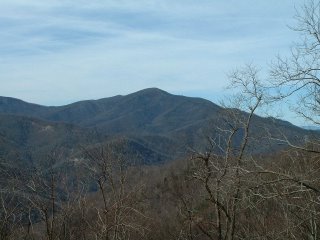The hike that never happened

The hike that never happened was this past weekend. The plan was to go to the Shining Rock Wilderness and hike in to the rock and take as much time as possible to do it and allow all the sights, sounds and smells of late fall soak into the brain. I have never been to Shining Rock and was pretty excited to go and see this unusual rock formation. Shining Rock is named for the white quartzite rock that forms its summit, Shining Rock's 5940 foot peak is not the highest in the wilderness area. In fact, Shining Rock Ledge, which forms the backbone of the area, boasts three peaks over 6000 feet, the highest being Cold Mountain at 6030 ft. If Cold Mountain sounds familiar, it should. This is the Cold Mountain of Charles Frazier's bestselling and Pulitzer Prize winning novel, Cold Mountain . The literary types should be aware that the hike to Cold Mountain is no walk in the park. It is a 10.6 mile hike (one way) from the Daniel Boone Camp trailhead via the Art Loeb and Cold Mountain Trails. So needless to say, this trail is not for someone looking for an easy little walk in the woods. This is a serious trail with steep assents. As Frazier recounts in his novel, the Shining Rock area was originally part of the Cherokee Nation. White settlers began pouring in following a land grant from the state of North Carolina in 1796. Champion Fibre Company purchased most of the area between 1906 and 1909 and began logging the area to supply its pulp mill in nearby Canton.In 1911, Champion Fibre decided the area's forests produced better sawtimber than pulp, so the tract was sold to Champion Lumber, which in turn sold it to Suncrest Lumber in 1918.Continuous logging between 1906 and 1926 decimated large stands of red spruce, Frazer fir, hemlock and hardwoods. Remnant stands of isolated spruce and fir survive today on some of the ridge tops, though these stands are threatened by acid precipitation and insects. The Cherokee deliberately used fire to alter the ecology of the region. More recently, in 1925 a locomotive ignited a pile of logging slash that quickly spread and consumed over 25,000 acres before it was extinguished.
We did however, ride back down the mountain and motor over to the Wildlife Education Center on the backside of Looking Glass Rock. This is where another prominent rock feature known as John Rock can be found. There are plenty of trails around this area that has made on my to do list for the near future. But for now they will have to wait.
Anyway….all that having been said, we arrived at the Big East Fork Trail Head around 1:30pm and with 10 miles of hiking ahead of us walking an average of one mile per hour, well………you do the math. So the hike that never happened will happen sameday I hope.
0 Comments:
Post a Comment
<< Home